Single-cell sequencing reveals effects of chemotherapy on the immune landscape and TCR/BCR clonal expansion in a relapsed ovarian cancer patient
- PMID: 36248860
- PMCID: PMC9555851
- DOI: 10.3389/fimmu.2022.985187
Single-cell sequencing reveals effects of chemotherapy on the immune landscape and TCR/BCR clonal expansion in a relapsed ovarian cancer patient
Abstract
Cancer recurrence and chemoresistance are the leading causes of death in high-grade serous ovarian cancer (HGSOC) patients. However, the unique role of the immune environment in tumor progression for relapsed chemo-resistant patients remains elusive. In single-cell resolution, we characterized a comprehensive multi-dimensional cellular and immunological atlas from tumor, ascites, and peripheral blood of a chemo-resistant patient at different stages of treatment. Our results highlight a role in recurrence and chemoresistance of the immunosuppressive microenvironment in ascites, including MDSC-like myeloid and hypo-metabolic γδT cells, and of peripheral CD8+ effector T cells with chemotherapy-induced senescent/exhaustive. Importantly, paired TCR/BCR sequencing demonstrated relative conservation of TCR clonal expansion in hyper-expanded CD8+ T cells and extensive BCR clonal expansion without usage bias of V(D)J genes after chemotherapy. Thus, our study suggests strategies for ameliorating chemotherapy-induced immune impairment to improve the clinical outcome of HGSOC.
Keywords: TCR/BCR repertoire; chemotherapy; clonal expansion; immune microenvironment; ovarian cancer; single-cell sequencing.
Copyright © 2022 Ren, Li, Feng, Xie, Gao, Chu, Li, Meng and Ning.
Conflict of interest statement
The authors declare that the research was conducted in the absence of any commercial or financial relationships that could be construed as a potential conflict of interest.
Figures
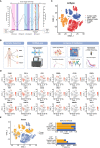
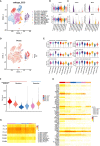
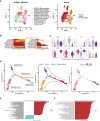
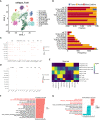
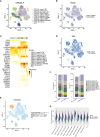
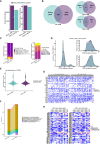
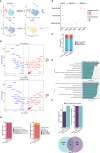
Similar articles
-
Adaptive transcriptomic and immune infiltrate responses in the tumor immune microenvironment following neoadjuvant chemotherapy in high grade serous ovarian cancer reveal novel prognostic associations and activation of pro-tumorigenic pathways.Front Immunol. 2022 Sep 5;13:965331. doi: 10.3389/fimmu.2022.965331. eCollection 2022. Front Immunol. 2022. PMID: 36131935 Free PMC article.
-
Altered tumor signature and T-cell profile after chemotherapy reveal new therapeutic opportunities in high-grade serous ovarian carcinoma.Cancer Sci. 2024 Mar;115(3):989-1000. doi: 10.1111/cas.16074. Epub 2024 Jan 16. Cancer Sci. 2024. PMID: 38226451 Free PMC article.
-
Spatial heterogeneity of infiltrating T cells in high-grade serous ovarian cancer revealed by multi-omics analysis.Cell Rep Med. 2022 Dec 20;3(12):100856. doi: 10.1016/j.xcrm.2022.100856. Cell Rep Med. 2022. PMID: 36543113 Free PMC article.
-
Revealing Clonal Responses of Tumor-Reactive T-Cells Through T Cell Receptor Repertoire Analysis.Front Immunol. 2022 Jan 27;13:807696. doi: 10.3389/fimmu.2022.807696. eCollection 2022. Front Immunol. 2022. PMID: 35154125 Free PMC article. Review.
-
Immune Tumor Microenvironment in Ovarian Cancer Ascites.Int J Mol Sci. 2022 Sep 14;23(18):10692. doi: 10.3390/ijms231810692. Int J Mol Sci. 2022. PMID: 36142615 Free PMC article. Review.
Cited by
-
Multi‑omics identification of a novel signature for serous ovarian carcinoma in the context of 3P medicine and based on twelve programmed cell death patterns: a multi-cohort machine learning study.Mol Med. 2025 Jan 8;31(1):5. doi: 10.1186/s10020-024-01036-x. Mol Med. 2025. PMID: 39773329 Free PMC article.
-
Neglected Anatomical Areas in Ovarian Cancer: Significance for Optimal Debulking Surgery.Cancers (Basel). 2024 Jan 9;16(2):285. doi: 10.3390/cancers16020285. Cancers (Basel). 2024. PMID: 38254777 Free PMC article. Review.
-
Identification of peripheral blood immune infiltration signatures and construction of monocyte-associated signatures in ovarian cancer and Alzheimer's disease using single-cell sequencing.Heliyon. 2023 Jun 27;9(7):e17454. doi: 10.1016/j.heliyon.2023.e17454. eCollection 2023 Jul. Heliyon. 2023. PMID: 37449151 Free PMC article.
-
Single-cell RNA-seq reveals intratumoral heterogeneity in osteosarcoma patients: A review.J Bone Oncol. 2023 Mar 20;39:100475. doi: 10.1016/j.jbo.2023.100475. eCollection 2023 Apr. J Bone Oncol. 2023. PMID: 37034356 Free PMC article. Review.
-
Platinum-based chemotherapy promotes antigen presenting potential in monocytes of patients with high-grade serous ovarian carcinoma.Front Immunol. 2024 Sep 9;15:1414716. doi: 10.3389/fimmu.2024.1414716. eCollection 2024. Front Immunol. 2024. PMID: 39315092 Free PMC article.
References
Publication types
MeSH terms
Substances
LinkOut - more resources
Full Text Sources
Medical
Molecular Biology Databases
Research Materials

